| Listing 1 - 10 of 12 | << page >> |
Sort by
|
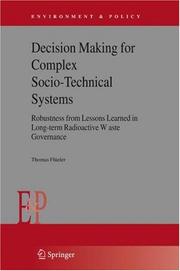
ISBN: 1280461071 9786610461073 1402035292 1402034806 9400789084 Year: 2006 Publisher: Dordrecht ; [London] : Springer,
Abstract | Keywords | Export | Availability | Bookmark
 Loading...
Loading...Choose an application
- Reference Manager
- EndNote
- RefWorks (Direct export to RefWorks)
The long-term governance of radioactive waste continues to be a major complex and contentious socio-technical issue worldwide. Traditionally, it has been considered as mainly a challenge to scientists and engineers to develop technical "solutions" to specific problems. But increasingly these narrow solutions have been enlarged by wider societal considerations such as ethics, public involvement, control and retrievability – needs that have in the meanwhile been recognised by the nuclear community, at least in a general way. In this book, we analyse motives for a broad discourse as well as suggest prerequisites to launch it. The author attempts to give a novel, empirically based and technically sound treatment of fundamental issues in long-term management and governance. Written to be accessible to a wide selection of the interested public, the study proposes a combination of technical design issues, analysis methods and institutional backup in a dynamic procedure, and with involvement at all levels of political, commercial and social life.
Radioactive wastes --- Management. --- Social aspects. --- Nuclear wastes --- Radwastes --- Wastes, Nuclear --- Wastes, Radioactive --- Hazardous wastes --- Nuclear engineering --- Radioactive substances --- Waste disposal. --- Environmental management. --- Economics. --- Environmental toxicology. --- Environmental protection. --- Waste Management/Waste Technology. --- Environmental Management. --- Political Economy/Economic Systems. --- Ecotoxicology. --- Effects of Radiation/Radiation Protection. --- Environmental quality management --- Protection of environment --- Environmental sciences --- Applied ecology --- Environmental engineering --- Environmental policy --- Environmental quality --- Ecotoxicology --- Pollutants --- Pollution --- Environmental health --- Toxicology --- Economic theory --- Political economy --- Social sciences --- Economic man --- Environmental stewardship --- Stewardship, Environmental --- Management --- Monograph --- Waste management. --- Economic policy. --- Radiation protection. --- Radiation—Safety measures. --- Radiation monitoring --- Radiation protection --- Economic nationalism --- Economic planning --- National planning --- State planning --- Economics --- Planning --- National security --- Social policy
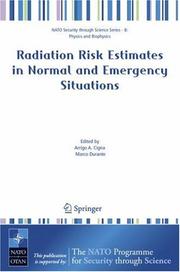
ISBN: 9781402049545 1402049544 1402049552 9786610726783 1280726784 1402049560 Year: 2006 Publisher: Dordrecht, Netherlands : Springer in cooperation with NATO Public Diplomacy Division,
Abstract | Keywords | Export | Availability | Bookmark
 Loading...
Loading...Choose an application
- Reference Manager
- EndNote
- RefWorks (Direct export to RefWorks)
In September 2005, Yerevan (Armenia) hosted an International Conference dedicated to the 70th anniversary of the publication of the so called "green paper", published by N.W. Timofeeff-Ressovsky, K. Zimmer and M. Delbruck in 1935, entitled "On the origin of gene mutations and gene structure". The importance of this paper for genetics and radiobiology was enormous – not only for radiobiology, but for genetics in general. The "target" of the radiation action was indeed the "gene", that for the first time found a clear, operational definition. The organisers of this Conference proposed to convene scientists from all over the world to discuss the impact of radiation risk estimates in normal and emergency situations. This was the starting point of the NATO Advanced Research Workshop, whose proceedings are published in this book. The parallel development of the Conference and the Workshop resulted in a true synergism, both events taking advantage of the mixed environment of molecular biologists, genetists, radiobiologists, radioecologists, biophysicists, etc. gathered in Yerevan. We were delighted to include a few excellent papers dealing directly with Timofeeff-Ressovsky’s life, and the "green pamphlet". The life and scientific achievements of Timofeeff-Ressovsky are often not well known in western countries, hence we deemed it advisable to include those papers in this book.
Radiation --- Radiation carcinogenesis --- Rayonnement --- Safety measures --- Congresses. --- Dosage --- Sécurité --- Mesures --- Congrès --- Radiation -- Dosage -- Congresses. --- Radiation -- Safety measures -- Congresses. --- Radiation carcinogenesis -- Congresses. --- Risk Assessment --- Congresses --- Radiation Dosage --- Radiation Effects --- Safety --- Radiologic Health --- Epidemiologic Measurements --- Risk --- Radiometry --- Accident Prevention --- Publication Formats --- Risk Management --- Accidents --- Probability --- Public Health --- Investigative Techniques --- Electromagnetic Phenomena --- Organization and Administration --- Publication Characteristics --- Environment and Public Health --- Health Services Administration --- Statistics as Topic --- Analytical, Diagnostic and Therapeutic Techniques and Equipment --- Physical Phenomena --- Phenomena and Processes --- Epidemiologic Methods --- Health Care --- Health Care Evaluation Mechanisms --- Quality of Health Care --- Health Care Quality, Access, and Evaluation --- Nuclear Engineering --- Environmental Sciences --- Earth & Environmental Sciences --- Mechanical Engineering --- Engineering & Applied Sciences --- Risk estimates --- Environment. --- History. --- Human genetics. --- Ecology. --- Biophysics. --- Biological physics. --- Radiation protection. --- Effects of Radiation/Radiation Protection. --- Human Genetics. --- Biophysics and Biological Physics. --- History of Science. --- Safety measures. --- Radiation monitoring --- Radiation protection --- Biological physics --- Biology --- Medical sciences --- Physics --- Balance of nature --- Bionomics --- Ecological processes --- Ecological science --- Ecological sciences --- Environment --- Environmental biology --- Oecology --- Environmental sciences --- Population biology --- Genetics --- Heredity, Human --- Human biology --- Physical anthropology --- Annals --- Auxiliary sciences of history --- Ecology --- Environmental protection. --- Biological and Medical Physics, Biophysics. --- Environmental quality management --- Protection of environment --- Applied ecology --- Environmental engineering --- Environmental policy --- Environmental quality --- Radiation—Safety measures. --- Ecology .
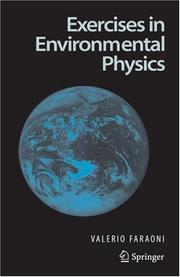
ISBN: 1280743883 9786610743889 0387358358 0387339124 1441922229 Year: 2006 Publisher: New York : Springer,
Abstract | Keywords | Export | Availability | Bookmark
 Loading...
Loading...Choose an application
- Reference Manager
- EndNote
- RefWorks (Direct export to RefWorks)
Exercises in Environmental Physics covers the essential topics in university courses in environmental physics including: -Energy and the environment -Fluid mechanics -Evapotranspiration, soil physics and groundwater hydrology -Pollution -Ocean and atmospheric physics -The planet in space This is the first book specifically devoted to exercises on the application of physics to describe the environment including the human impact. It is a valuable tool for students to develop skills in the manipulation of physical concepts and methods while learning environmental science. The exercises are drawn from the author's teaching experience and the need for stimulating practice problems in various environmental physics courses. A chapter on mathematical methods used in the book supplements the material.
Environmental sciences. --- Physics. --- Atmospheric physics. --- Environmental science --- Science --- Aerophysics --- Atmospheric sciences --- Physical meteorology --- Geophysics --- Natural philosophy --- Philosophy, Natural --- Physical sciences --- Dynamics --- Meteorology, Physical --- Atmospheric science --- Physical geography. --- Environmental protection. --- Biotechnology. --- Environmental Science and Engineering. --- Environmental Physics. --- Atmospheric Protection/Air Quality Control/Air Pollution. --- Effects of Radiation/Radiation Protection. --- Math. Appl. in Environmental Science. --- Environmental Engineering/Biotechnology. --- Chemical engineering --- Genetic engineering --- Environmental quality management --- Protection of environment --- Environmental sciences --- Applied ecology --- Environmental engineering --- Environmental policy --- Environmental quality --- Geography --- Air pollution. --- Radiation protection. --- Radiation—Safety measures. --- Environmental engineering. --- Radiation monitoring --- Radiation protection --- Air --- Air contaminants --- Air pollutants --- Air pollution --- Air pollution control --- Air toxics --- Airborne pollutants --- Atmosphere --- Contaminants, Air --- Control of air pollution --- Pollutants, Air --- Toxics, Air --- Pollution --- Air quality --- Atmospheric deposition --- Environmental control --- Environmental effects --- Environmental stresses --- Engineering --- Environmental health --- Environmental protection --- Sustainable engineering --- Control
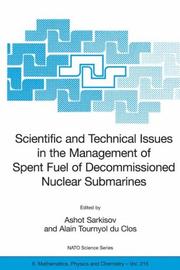

ISBN: 1402041721 1402041713 140204173X 9786610427352 1280427353 Year: 2006 Volume: 215 Publisher: Dordrecht Brussels Springer Nato Public Diplomacy Division
Abstract | Keywords | Export | Availability | Bookmark
 Loading...
Loading...Choose an application
- Reference Manager
- EndNote
- RefWorks (Direct export to RefWorks)
Similar to the three previous publications, which collected the materials of the NATO-Russia ARWs held in Moscow in 1995, 1997 and 2002, this fourth book addresses a very important challenge of the present – complex decommissioning of the nuclear-powered vessels taken out of service and environmental rehabilitation of the centers of basing and everyday running of different-type nuclear vessels. The fourth book specifically focuses on the scientific and technical problems of management of naval spent nuclear fuel and radioactive waste. Some papers address the first results of the "Strategic Master-plan ("Master-plan") for complex decommissioning of Russian nuclear-powered vessels" developed in Russia with active participation and large financial support of the international community. This fourth book, taken together with the papers of the three previous NATO ARWs published earlier, represents the most complete collection of materials on complex decommissioning of nuclear-powered vessels including the spent nuclear fuel management-related challenge.
Spent reactor fuels --- Nuclear submarines --- Radioactive waste disposal --- Combustibles nucléaires irradiés --- Sous-marins nucléaires --- Déchets radioactifs --- Management --- Congresses --- Decommissioning --- Congresses. --- Gestion --- Congrès --- Déclassement --- Elimination --- Spent reactor fuels. --- Nuclear Engineering --- Mechanical Engineering --- Engineering & Applied Sciences --- Combustibles nucléaires irradiés --- Sous-marins nucléaires --- Déchets radioactifs --- Congrès --- Déclassement --- EPUB-LIV-FT LIVINGEN SPRINGER-B --- Atomic submarines --- Nuclear-powered submarines --- Engineering. --- Nuclear energy. --- Nuclear engineering. --- Radiation protection. --- Radiation --- Waste management. --- Nuclear Engineering. --- Effects of Radiation/Radiation Protection. --- Waste Management/Waste Technology. --- Nuclear Energy. --- Safety measures. --- Nuclear warships --- Submarines (Ships) --- Fleet ballistic missile weapons systems --- Nuclear fuels --- Reactor fuel reprocessing --- Environmental protection. --- Waste disposal. --- Environmental quality management --- Protection of environment --- Environmental sciences --- Applied ecology --- Environmental engineering --- Environmental policy --- Environmental quality --- Radiation—Safety measures. --- Radiation monitoring --- Radiation protection --- Atomic energy --- Atomic power --- Energy, Atomic --- Energy, Nuclear --- Nuclear power --- Power, Atomic --- Power, Nuclear --- Force and energy --- Nuclear physics --- Power resources --- Nuclear engineering --- Nuclear facilities --- Nuclear power plants
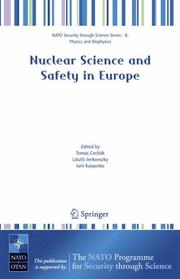
ISSN: 1871465X ISBN: 9781402049637 1402049633 1402049641 9786610745449 1280745444 140204965X Year: 2006 Publisher: Dordrecht, The Netherlands : Springer : NATO Public Diplomacy Division,
Abstract | Keywords | Export | Availability | Bookmark
 Loading...
Loading...Choose an application
- Reference Manager
- EndNote
- RefWorks (Direct export to RefWorks)
Recent results on the nature of low-, intermediate- and high-energy nuclear forces as well as on the internal structure of nucleons and atomic nuclei are presented. Prospects to find a new state of the nuclear matter at extreme conditions that existed in the early Universe and the utilisation of the nuclear energy are discussed.
Nuclear forces (Physics) --- Nuclear engineering --- Génie nucléaire --- Congresses --- Safety measures --- Sécurité --- Mesures --- Congrès --- Nuclear engineering -- Safety measures -- Congresses. --- Nuclear engineering. --- Nuclear forces (Physics) -- Congresses. --- Physics --- Physical Sciences & Mathematics --- Nuclear Physics --- Specifically nuclear forces --- Physics. --- Nuclear physics. --- Heavy ions. --- Hadrons. --- Particle acceleration. --- Radiation protection. --- Radiation --- Particle and Nuclear Physics. --- Theoretical, Mathematical and Computational Physics. --- Nuclear Physics, Heavy Ions, Hadrons. --- Particle Acceleration and Detection, Beam Physics. --- Effects of Radiation/Radiation Protection. --- Safety measures. --- Binding energy --- Nuclear physics --- Particles (Nuclear physics) --- Environmental protection. --- Environmental quality management --- Protection of environment --- Environmental sciences --- Applied ecology --- Environmental engineering --- Environmental policy --- Environmental quality --- Acceleration (Mechanics) --- Atomic nuclei --- Atoms, Nuclei of --- Nucleus of the atom --- Acceleration --- Mathematical physics. --- Radiation—Safety measures. --- Radiation monitoring --- Radiation protection --- Ions --- Physical mathematics --- Mathematics
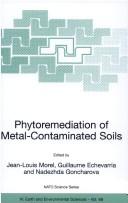

ISBN: 9781402046889 1402046863 9781402046865 1402046871 9786610612826 1280612827 140204688X Year: 2006 Volume: v. 68 Publisher: Dordrecht Springer
Abstract | Keywords | Export | Availability | Bookmark
 Loading...
Loading...Choose an application
- Reference Manager
- EndNote
- RefWorks (Direct export to RefWorks)
Phytoremediation, the use of plants to remediate environmental media, is being pursued as a new approach for the cleanup of contaminated soils and waters, including groundwater. Plant-assisted bioremediation, sometimes referred to as a type of phytoremediation, involves the interaction of plant roots and the microorganisms associated with these root systems to re- diate soils containing elevated concentrations of organic compounds. These techniques could provide cost-effective methods of remediating soils and groundwater contaminated with metals, radionuclides, and various types of organics, with fewer secondary wastes and less environmental impact than would be generated using traditional remediation methods. All plants extract necessary nutrients, including metals, from their soil and water environments. Some plants, called hyperaccumulators, have the ability to store large amounts of metals, even some metals that do not appear to be required for plant functioning. In addition, plants can take up various organic chemicals from environmental media and degrade or otherwise process them for use in their physiological processes. Phytoremediation technologies are in the early stages of development, with laboratory research and limited field trials being conducted to determine processes and refine methods. Additional research, including genetic engineering, is being conducted to improve the natural capabilities of plants to perform remediation functions and to investigate other plants with potential phytoremediation applications. Large areas in Western and Eastern countries are polluted with heavy metals and radionuclides in natural, rural, urban or industrial areas.
milieutechnologie --- milieuanalyse --- bodembescherming --- Science --- Pedology --- biotechnologie --- wetenschappen --- milieubeheer --- stralingshygiëne --- Biotechnology --- Radiotherapy. Isotope therapy --- bodemkunde --- Hygiene. Public health. Protection --- milieuzorg --- Environmental protection. Environmental technology --- wetenschap --- Soil remediation --- Soil pollution --- Phytoremediation --- Sols --- Phytorestauration --- Congresses. --- Congresses --- Décontamination --- Congrès --- Pollution --- EPUB-LIV-FT LIVCHIMI SPRINGER-B --- Biotechnology. --- Environmental protection. --- Environmental toxicology. --- Soil conservation. --- Effects of Radiation/Radiation Protection. --- Ecotoxicology. --- Soil Science & Conservation. --- Environmental Engineering/Biotechnology. --- Science, Humanities and Social Sciences, multidisciplinary. --- Conservation of soil --- Erosion control, Soil --- Soil erosion --- Soil erosion control --- Soils --- Agricultural conservation --- Soil management --- Ecotoxicology --- Pollutants --- Environmental health --- Toxicology --- Environmental quality management --- Protection of environment --- Environmental sciences --- Applied ecology --- Environmental engineering --- Environmental policy --- Environmental quality --- Chemical engineering --- Genetic engineering --- Control --- Prevention --- Conservation --- Radiation protection. --- Radiation—Safety measures. --- Soil science. --- Environmental engineering. --- Radiation monitoring --- Radiation protection --- Environmental control --- Environmental effects --- Environmental stresses --- Engineering --- Environmental protection --- Sustainable engineering --- Pedology (Soil science) --- Agriculture --- Earth sciences --- Metal contaminated soils --- NATO
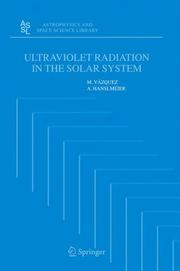
ISBN: 1280624442 9786610624447 1402037309 1402037260 9048169437 Year: 2006 Publisher: Dordrecht ; [Great Britain] : Springer,
Abstract | Keywords | Export | Availability | Bookmark
 Loading...
Loading...Choose an application
- Reference Manager
- EndNote
- RefWorks (Direct export to RefWorks)
UV radiation is an important part in the electromagnetic spectrum since the energy of the photons is great enough to produce important chemical reactions in the atmospheres of planets and satellites of our Solar System, thereby affecting the transmission of this radiation to the ground and its physical properties. Scientists have used different techniques (balloons and rockets) to access to the information contained in this radiation, but the pioneering of this new frontier has not been free of dangers. The Sun is our main source of UV radiation and its description occupies the first two chapters of the book. The Earth is the only known location where life exists in a planetary system and therefore where the interaction of living organism with UV radiation can be tested through different epochs and on distinct species. The development of the human technology has affected the natural shield of ozone that protects complex lifeforms against damaging UV irradiation. The formation of the ozone hole and its consequences are described, together with the possible contribution of UV radiation to recent climate changes. Finally, we will discuss the potential role of ultraviolet light in the development of life on bodies such as Mars, Europa and Titan. The Solar System is not isolated; other external sources can contribute to the enhancement of the UV radiation in our environment. The influence of such events as nearby supernovae and gamma-ray bursts are described, together with the consequences to terrestrial life from such events.
Ultraviolet radiation. --- Solar radiation. --- Astrophysics. --- Solar system. --- Milky Way --- Astronomical physics --- Astronomy --- Cosmic physics --- Physics --- Absorption, Atmospheric --- Atmospheric absorption of solar radiation --- Insolation --- Radiation, Solar --- Electromagnetic waves --- Black light --- Light, Black --- Light, Ultraviolet --- Rays, Ultraviolet --- U-V light --- U-V radiation --- U-V rays --- Ultra-violet radiation --- Ultra-violet rays --- Ultraviolet light --- Ultraviolet rays --- UV light --- UV radiation --- UV rays --- Radiation --- Astrobiology. --- Oncology. --- Climatic changes. --- Environmental protection. --- Astrophysics and Astroparticles. --- Astronomy, Observations and Techniques. --- Cancer Research. --- Climate Change. --- Effects of Radiation/Radiation Protection. --- Environmental quality management --- Protection of environment --- Environmental sciences --- Applied ecology --- Environmental engineering --- Environmental policy --- Environmental quality --- Changes, Climatic --- Changes in climate --- Climate change --- Climate change science --- Climate changes --- Climate variations --- Climatic change --- Climatic changes --- Climatic fluctuations --- Climatic variations --- Global climate changes --- Global climatic changes --- Climatology --- Climate change mitigation --- Teleconnections (Climatology) --- Tumors --- Astrobiology --- Biology --- Habitable planets --- Life --- Environmental aspects --- Origin --- Observations, Astronomical. --- Astronomy—Observations. --- Cancer research. --- Climate change. --- Radiation protection. --- Radiation—Safety measures. --- Radiation monitoring --- Radiation protection --- Cancer research --- Astronomical observations --- Observations, Astronomical --- Global environmental change
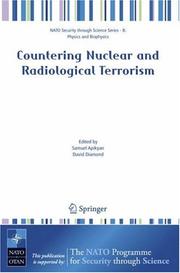
ISBN: 9781402048975 1402048971 140204920X 9786610611089 1280611081 1402049218 Year: 2006 Publisher: Dordrecht, Netherlands : Springer,
Abstract | Keywords | Export | Availability | Bookmark
 Loading...
Loading...Choose an application
- Reference Manager
- EndNote
- RefWorks (Direct export to RefWorks)
In recognition that no single country possesses all the answers to the critical scientific, institutional and legal questions associated with combating nuclear and radiological terrorism, the 2005 Workshop and these proceedings were structured to promote wide-ranging, multi-national exploration of critical technology needs and underlying scientific challenges to reducing the threat of nuclear/radiological terrorism; to illustrate through country-specific presentations how resulting technologies were used in national programs; and to outline the role of legal, policy and institutional frameworks in countering nuclear/radiological terrorism. One key outcome of this book is a better understanding of the independent contributions from across the international community of the scientific and technological components and the legal, policy and institutional components to combating nuclear/radiological terrorism. The book can serve as a tool for communicating the outcomes of the workshop to the multi-national scientific communities engaged in combating nuclear/radiological terrorism, and to those working at governmental and policy levels.
Nuclear terrorism --- Chemical terrorism --- Nuclear energy --- Nuclear engineering --- Nuclear nonproliferation --- Nuclear power plants --- Génie nucléaire --- Non-prolifération nucléaire --- Centrales nucléaires --- Congresses --- Safety measures --- Sécurité --- Mesures --- Congrès --- Mesures de sécurité --- Chemical terrorism -- Congresses. --- Nuclear energy -- Safety measures -- Congresses. --- Nuclear engineering -- Safety measures -- Congresses. --- Nuclear nonproliferation -- Congresses. --- Nuclear power plants -- Safety measures -- Congresses. --- Nuclear terrorism -- Congresses. --- Nuclear Engineering --- Criminology, Penology & Juvenile Delinquency --- Mechanical Engineering --- Social Welfare & Social Work --- Social Sciences --- Engineering & Applied Sciences --- Nuclear terrorism. --- Safety measures. --- Atomic energy --- Atomic power --- Energy, Atomic --- Energy, Nuclear --- Nuclear power --- Power, Atomic --- Power, Nuclear --- Engineering. --- Nuclear energy. --- Particle acceleration. --- Nuclear fusion. --- Quality control. --- Reliability. --- Industrial safety. --- Nuclear engineering. --- Radiation protection. --- Radiation --- Nuclear Engineering. --- Effects of Radiation/Radiation Protection. --- Quality Control, Reliability, Safety and Risk. --- Particle Acceleration and Detection, Beam Physics. --- Nuclear Fusion. --- Nuclear Energy. --- Terrorism --- Force and energy --- Nuclear physics --- Power resources --- Nuclear facilities --- Environmental protection. --- System safety. --- Fusion, Nuclear --- Fusion reactions --- Fusion --- Nuclear reactions --- Particles (Nuclear physics) --- Acceleration (Mechanics) --- Safety, System --- Safety of systems --- Systems safety --- Accidents --- Industrial safety --- Systems engineering --- Environmental quality management --- Protection of environment --- Environmental sciences --- Applied ecology --- Environmental engineering --- Environmental policy --- Environmental quality --- Acceleration --- Prevention --- Radiation—Safety measures. --- Factory management --- Industrial engineering --- Reliability (Engineering) --- Sampling (Statistics) --- Standardization --- Quality assurance --- Quality of products --- Radiation monitoring --- Radiation protection --- Industrial accidents --- Industries --- Job safety --- Occupational hazards, Prevention of --- Occupational health and safety --- Occupational safety and health --- Prevention of industrial accidents --- Prevention of occupational hazards --- Safety, Industrial --- Safety engineering --- Safety of workers --- System safety --- Dependability --- Trustworthiness --- Conduct of life
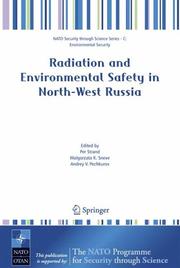
ISBN: 9781402046490 9781402046476 9781402046483 1402046472 1402046480 1402046499 9786610616817 1280616814 Year: 2006 Volume: 9 Publisher: Dordrecht, Netherlands : Springer,
Abstract | Keywords | Export | Availability | Bookmark
 Loading...
Loading...Choose an application
- Reference Manager
- EndNote
- RefWorks (Direct export to RefWorks)
The NATO Advanced Research Workshop on “Radiation and Envir- mental Safety in North-West Russia — Use of Impact Assessments and Risk Estimation” was held in Moscow, Russia on December 8 - 10, 2004. The workshop was sponsored by the NATO Science Committee and N- wegian Radiation Protection Authority (NRPA) and organised jointly by Rostechnadzor and NRPA. The objective of this workshop was to examine how scientific research and environmental studies, including the effects and distribution of radiation and radionuclides, can contribute to development of practical standards for protection of the environment and human health. The intention was to s- port operators and regulators involved in radioactive waste management projects in Northwest Russia. The workshop attracted wide participation from relevant Russian and western organizations. International expertise from several related fields went together to produce a thorough understanding of the present status and how to develop the use of overall risk assessments and environmental impact assessments to ensure a sound use of resources when carrying out the tremendous work that must be carried out to clean up the cold war l- acy. Important conclusions and recommendations have been produced and set out in the main report, providing a good basis for further development. Such development should note that safety and environmental performance can be addressed at three levels: a) Compliance-focused; b) Beyond compliance, towards best practice; and c) Continuous improvement.
milieutechnologie --- wetenschappen --- milieubeheer --- Computer. Automation --- Science --- Environmental law --- informatica --- stralingshygiëne --- milieubeleid --- milieurecht --- Radiotherapy. Isotope therapy --- Hygiene. Public health. Protection --- Environmental protection. Environmental technology --- wetenschap --- Radiation --- Environmental risk assessment --- Nuclear power plants --- Rayonnement --- Environnement --- Centrales nucléaires --- Safety measures. --- Risk assessment --- Sécurité --- Mesures --- Evaluation du risque --- EPUB-LIV-FT Environmental North-West Radiation Russia SPRINGER-B safety --- Environmental sciences. --- Environmental protection. --- Environmental law. --- Environmental management. --- Environment, general. --- Effects of Radiation/Radiation Protection. --- Monitoring/Environmental Analysis. --- Environmental Law/Policy/Ecojustice. --- Environmental Management. --- Science, Humanities and Social Sciences, multidisciplinary. --- Environmental stewardship --- Stewardship, Environmental --- Environmental sciences --- Management --- Environment law --- Environmental control --- Environmental protection --- Environmental quality --- Environmental policy --- Law --- Sustainable development --- Environmental quality management --- Protection of environment --- Applied ecology --- Environmental engineering --- Environmental science --- Law and legislation --- Environment. --- Radiation protection. --- Radiation—Safety measures. --- Environmental monitoring. --- Environmental policy. --- Biomonitoring (Ecology) --- Ecological monitoring --- Monitoring, Environmental --- Pollution --- Radiation monitoring --- Radiation protection --- Environment and state --- Environmental management --- State and environment --- Environmental auditing --- Measurement --- Monitoring --- Government policy --- Precautionary principle --- Atomic power plants --- Nuclear power stations --- Nuclear facilities --- Power-plants --- Antinuclear movement --- Nuclear energy

ISBN: 9781402036965 9781402036958 9781402036973 1402036957 1402036965 1402036973 9786610624409 128062440X Year: 2006 Volume: 57 Publisher: Dordrecht : Springer,
Abstract | Keywords | Export | Availability | Bookmark
 Loading...
Loading...Choose an application
- Reference Manager
- EndNote
- RefWorks (Direct export to RefWorks)
This volume originates from the NATO Advanced Study Institute Environmental UV Radiation: Impact on Ecosystems and Human Health and Predictive Models, held in Pisa, Italy in June 2001. The Institute was sponsored and mainly funded by the NATO Scientific Affairs Division, whose constant contribution in favour of the cooperation among scientists from different countries must be acknowledged. Other Institutions substantially contributed to the success of the ASI and our thanks and appreciation go to the Italian National Research Council (Consiglio Nazionale delle Ricerche), the Italian Space Agency (Agenzia Spaziale Italiana), the European Society for Photobiology and the bank Banca Toscana. In the last two decades of the past century, concern has been growing for the possible effects on the biosphere of the stratospheric ozone depletion, due to anthropogenic emissions of ozone-destroying chemicals. The ozone loss causes an increase in the biologically important part of the solar ultraviolet radiation (UV) reaching the Earth’s surface, which constitutes a threat to the biosphere, because of UV damaging effects on humans, animals and plants. The international agreements have reduced the production of ozo- destroying compounds, which, however, are still present in high concentrations in the stratosphere, mainly because of their longevity, and thus ozone depletion will likely continue for several decades.
Ultraviolet radiation --- Plants --- Rayonnement ultraviolet --- Plantes, Effets du rayonnement ultraviolet sur les --- Environmental aspects --- Effect of ultraviolet radiation on --- Physiological effect --- Aspect de l'environnement --- Effets physiologiques --- Ultraviolet radiation. --- Ultraviolet Rays --- Water Pollutants, Radioactive --- Environmental Exposure --- Environmental Monitoring --- Public Health Practice --- Sunlight --- Light --- Environmental Pollution --- Water Pollutants --- Eukaryota --- Radioactive Pollutants --- Public Health --- Complex Mixtures --- Weather --- Radiation, Nonionizing --- Organisms --- Optical Phenomena --- Environmental Pollutants --- Environment and Public Health --- Chemicals and Drugs --- Radiation --- Atmosphere --- Meteorological Concepts --- Physical Phenomena --- Toxic Actions --- Health Care --- Environment --- Chemical Actions and Uses --- Ecological and Environmental Phenomena --- Phenomena and Processes --- Electromagnetic Phenomena --- Biological Phenomena --- Environmental Sciences --- Ecology --- Earth & Environmental Sciences --- Human beings --- EPUB-LIV-FT LIVECOLO SPRINGER-B --- Homo sapiens --- Human race --- Humanity (Human beings) --- Humankind --- Humans --- Man --- Mankind --- People --- Flora --- Plant kingdom --- Plantae --- Vascular plants --- Vegetable kingdom --- Vegetation --- Wildlife --- Black light --- Light, Black --- Light, Ultraviolet --- Rays, Ultraviolet --- U-V light --- U-V radiation --- U-V rays --- Ultra-violet radiation --- Ultra-violet rays --- Ultraviolet light --- Ultraviolet rays --- UV light --- UV radiation --- UV rays --- Environment. --- Plant ecology. --- Climate change. --- Radiation protection. --- Environmental health. --- Ecotoxicology. --- Effects of Radiation/Radiation Protection. --- Climate Change. --- Plant Ecology. --- Environmental Health. --- Safety measures. --- Ecotoxicology --- Pollutants --- Pollution --- Environmental health --- Toxicology --- Environmental quality --- Health --- Health ecology --- Public health --- Environmental engineering --- Health risk assessment --- Radiation monitoring --- Radiation protection --- Changes, Climatic --- Climate change --- Climate changes --- Climate variations --- Climatic change --- Climatic changes --- Climatic fluctuations --- Climatic variations --- Global climate changes --- Global climatic changes --- Climatology --- Climate change mitigation --- Teleconnections (Climatology) --- Botany --- Health aspects --- Hominids --- Persons --- Environmental protection. --- Climatic changes. --- Environmental Medicine. --- Environmental toxicology. --- Changes in climate --- Climate change science --- Environmental quality management --- Protection of environment --- Environmental sciences --- Applied ecology --- Environmental policy --- Phytoecology --- Vegetation ecology --- Radiation—Safety measures. --- Floristic ecology --- Environmental UV radiation --- Ecosystems --- Human health --- Global environmental change
| Listing 1 - 10 of 12 | << page >> |
Sort by
|

 Search
Search Feedback
Feedback About UniCat
About UniCat  Help
Help News
News